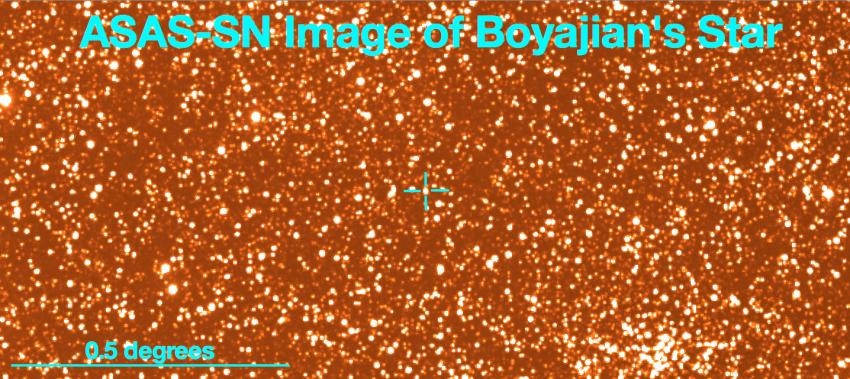Oct 5 2017
A star named KIC 8462852 was a top topic in and beyond the astronomy community during 2015 because of a chain of rapid, mysterious dimming events observed while it was being studied using NASA’s Kepler Space Telescope. And the star has unrelenting foiled Scientists’ efforts to understand it ever since.
 An inconspicuous star—KIC 8462852—harbors a great mystery. This ASAS-SN image is just a small portion of the sky, but shows how Tabby's star is one of millions. Image courtesy of Benjamin Shappee.
An inconspicuous star—KIC 8462852—harbors a great mystery. This ASAS-SN image is just a small portion of the sky, but shows how Tabby's star is one of millions. Image courtesy of Benjamin Shappee.
The newest findings from Carnegie’s Josh Simon and Benjamin Shappee and collaborators take an in depth look at the star, right back from 2006—before its peculiar behavior was spotted by Kepler. Astronomers had believed that the star was only becoming fainter with time, but the recent study reveals that it also brightened considerably in 2007 and 2014. These unanticipated episodes confound or rule out almost all the suggested ideas to explain the star’s perceived strangeness.
Guesswork to account for KIC 8462852’s drops in brightness has ranged from it having swallowed a neighboring planet to an abnormally large group of comets orbiting the star to an alien megastructure.
On the whole, stars can seem to dim because a cloud of dust and gas or a solid object like a planet passes between it and the observer, concealing and effectively dimming its brightness for a time. But even before this confirmation of two periods of increased brightness in the star’s past, the unpredictable dimming periods seen in KIC 8462852 were unlike anything Astronomers had formerly witnessed.
Last year, Simon and Ben Montet (then at Caltech, currently at University of Chicago), who is also a Co-author on this present study, found that from 2009 to 2012, KIC 8462852 dimmed by nearly 1%. Its brightness then decreased by a surprising 2% over just six months, remaining at around that level for the final six months of Kepler observations.
But the research team was keen to monitor KIC 8462852 over an extended period of time. So, they went back and studied nearly 11 years of observing data from the All Sky Automated Survey (ASAS) and approximately two years of more-recent data from the high-precision All-Sky Automated Survey for Supernovae (ASAS-SN).
They discovered that the star has persistently dimmed since 2015 and is currently 1.5% fainter than it was in February of that year. Furthermore, they revealed that besides the dimming the star has experienced from 2009 to 2013 and 2015 to now, it experienced two periods of brightening.
Up until this work, we had thought that the star’s changes in brightness were only occurring in one direction—dimming. The realization that the star sometimes gets brighter in addition to periods of dimming is incompatible with most hypotheses to explain its weird behavior.
Josh Simon, Carnegie Science
“An important next step will be to determine how the color of the star changes with time, especially during its brief dips in brightness,” added Shappee. “That information would help narrow down the possible explanations for why this star is doing such strange things.”
For example, if the dimming was the result of dust concealing the star from us, then it would seem to get redder as it dimmed. But if large objects were obstructing the star’s light, then no color variation would be seen.
“We haven’t solved the mystery yet,” Simon concluded. “But understanding the star's long-term changes is a key piece of the puzzle."
The Researchers received support from a NASA Hubble Fellowship, Caltech/the Jet Propulsion Laboratory, the National Science Foundation and the DOE Computational Science Graduate Fellowship.
ASAS-SN is supported by the Gordon and Betty Moore Foundation and the National Science Foundation, the Mt. Cuba Astronomical Foundation, the Center for Cosmology and AstroParticle Physics at the Ohio State University, the Chinese Academy of Sciences South America Center for Astronomy, the Villum Foundation, and George Skestos.
This research utilized NASA’s Astrophysics Data System Bibliographic Services and the SIMBAD database, operated at CDS, Strasbourg, France, as well as the International Variable Star Index database operated at AAVSO, Cambridge Massachusetts.